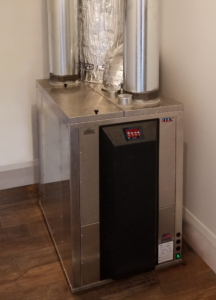Scottsdale, Arizona – Sep 6, 2022. Piera Systems (“Piera”) is pleased to announce the signing of a reseller agreement with Log6 Solutions (“Log6”), a Los Angeles based company offering innovative indoor air safety solutions. Under this agreement, Log6 will market, sell, and distribute the highly accurate Canāree™ family of Air Quality Monitors as part of their drive to improving safety in indoor spaces and protecting workplace environments. Canāree air quality monitors are built using the patented Intelligent Particle Sensor (“IPS”) technology from Piera and they combine ease-of-use and rapid deployment with unparalleled particle measurement and other environmental sensing capabilities.
The Canāree AQMs form a natural product and solution complement to the VIRUSKILLER™ air decontamination products that Log6 currently distributes throughout North America. By combining the accuracy and real-time monitoring of the Canāree AQMs with the VIRUSKILLER’s award-winning air cleaning capabilities, workspaces can ensure that their air is healthy in an energy-efficient manner.
“The pandemic has put the focus squarely on indoor air quality and we are excited to pair the highly accurate Canāree products with our incredibly effective VIRUSKILLER™ air decontamination products,” said Gregg Goodwin, President of Log6 Solutions. “Our partnership with Piera will allow us to deploy more complete indoor air quality solutions to our customers, ensuring healthy spaces and peace of mind.”
“We are excited to collaborate with Log6 Solutions to deliver more complete air quality solutions to customers in a wide range of applications from the entertainment industry to veterinary clinics and college campuses to the cannabis industry,” said Vin Ratford, CEO of Piera Systems. “Canāree AQMs are easy to use and can be instrumental in improving the energy efficiency of air decontamination products so this will be a natural complement to Log6’s existing services”.
Indoor air quality has direct and substantial impacts on human health, from loss of productivity to causing serious diseases including lung cancer, Alzheimer’s, and cardiovascular diseases. The smallest particles, less than 1 micron in size, are the most dangerous as they are readily absorbed into the bloodstream. Canāree monitors are independently certified to accurately detect these sub-micron particles compared to most other monitors that only provide estimates.
About Piera Systems, Inc.
Piera Systems Inc. is on a mission to make air quality measurement accurate, simple, inexpensive, and pervasive, enabling a major improvement in the health of all humans. Piera has developed a family of ‘Intelligent Particle Sensors’ utilizing a breakthrough custom processor to detect particulate matter (PM), a major component of air pollution. Unlike existing low-cost PM sensors, IPS has superior accuracy over a wider range, including harmful ‘very fine particles’ smaller than 1.0 micron, and reports particle size and count in real-time at low power. IPS is the first software defined PM sensor with up to 7 particle sizes allowing its use in many applications. IPS data is analyzed using AI/ML algorithms to identify and classify pollution sources such as vape, cigarette smoke, cooking, etc. IPS sensors and Canāree air quality monitors answer the question, ‘What’s In Your Air?’
Headquartered in the US, more information on Piera Systems air quality solutions can be found at https://www.pierasystems.com
About Log6 Solutions LLC
LOG6 SOLUTIONS LLC is dedicated to improving the health and safety of indoor spaces. Based in Los Angeles, Log6’s charter is to destroy deadly airborne pathogens and protect the workplace environment. Log6 provides highly effective disinfection products that are user friendly, chemical free, and pathogen deadly to a variety of industries including the entertainment, education, healthcare, and cannabis industries. For more information on Log6 Solutions’ indoor air safety solutions, please visit www.log6solutions.com.
Contact Information
Raj Seelam
Vice President of Marketing & Customer Success
Kelsey Smith
Director of Digital Marketing & Social Media















